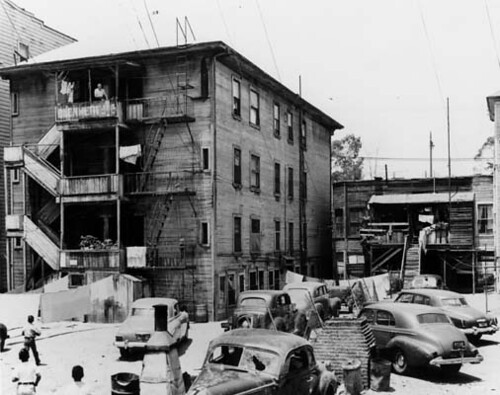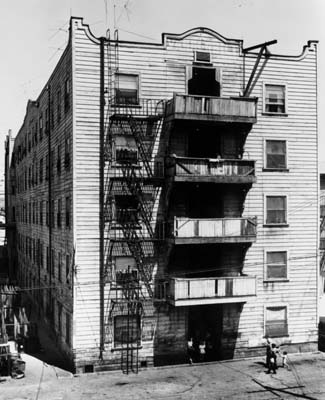Location: 334 South Figueroa

It is unlikely that the overcrowded, structurally unsound, 5-story Vanderbilt apartment-hotel at 334 S. Figueroa was a happy home for many of its tenants. However, children living in, or even passing by, the ramshackle building seemed to fare particularly badly. On April 5, 1939, 18-month-old Harvey Fish fell from a fourth story window, landing at the feet of his mother who was standing on the sidewalk below. The child suffered a fractured skull, and died later that day. 6-year-old Anna Lee Norton fell five stories shortly after Christmas in 1952. While playing on the apartment balcony, Anna lost her balance and crashed through a loose board, falling on a paved alleyway. Perhaps this should have been a sign to the Department of
Building and Safety and the CRA that the building was in trouble.
Other incidents at the Vanderbilt could be chalked up to sad or unfortunate chance. In 1949, Robert Lee Gordon, age 6, was killed when he darted out from between two cars parked in front of the building. And in 1955, 1-year-old Gloria Howard was reunited with her family, residents at the Vanderbilt, after a harrowing evening in juvie. Lucille Parker, 33, wandered into a bar with the child, saying Gloria had been "given" to her in another local bar. The child’s  father, William Howard, later reported that he’d left a very intoxicated Lucille and his daughter alone in a car while he made a phone call. When he returned, the car was missing, as were Lucille and Gloria.
father, William Howard, later reported that he’d left a very intoxicated Lucille and his daughter alone in a car while he made a phone call. When he returned, the car was missing, as were Lucille and Gloria.
The most bizarre story of child endangerment at the Vanderbilt brings us to 1945, when Elaine Wisecarver was charged with contributing to the delinquency of a minor after abandoning her 3-year-old daughter with the building manager. It wasn’t the first time Wisecarver earned this charge. The previous year, the 22-year-old woman had eloped to Yuma with a 14-year-old boy, Ellsworth (Sonny) Wisecarver. The marriage was later annulled, and Wisecarver was sentenced to 3 years probation.
However, on the evening of March 3, 1959, the Vanderbilt’s legacy came to an end in dramatic fashion when rotted underpinnings caused the floor joists to slip, and the 48-year-old building to slide off of its foundation, moving 3 feet sideways and dropping 2 feet. The side walls buckled, and plaster rained down on the buildings occupants, most of whom were at home at the time. In all, 200 of the hotel’s residents, 70 of them children, evacuated the building. One man was trapped in his apartment, but miraculously, only three people suffered injuries, all of them minor. In the days leading up to the collapse, several residents had complained to the building manager that they had trouble opening and closing their apartment doors.

The Red Cross immediately set up at the Fremont Grammar School, where approximately 40 adults and 60 children sought shelter.
Though the collapse came as a surprise to the Vanderbilt’s tenants, the building had actually been inspected a few weeks earlier and declared a hazard by the Department of Building and Safety. A hearing was being scheduled where the building’s owners would have to show cause why it should not be demolished.

Following the collapse, the building’s condition was downgraded to "immediate hazard," and demolition was scheduled. In fact, the building was declared so unsafe that no one was initially permitted to enter it, including the wrecking crew.
In the aftermath, the City Council asked Mayor Poulson to "define specifically the CRA’s activities," and to meet with its building and safety commission to discuss CRA procedure. This came as a result of the general manager of the Department and Building and Safety, Gilbert Morris’s report to the Council that the CRA had told his people to "keep out" of Bunker Hill. The Department also reported that the CRA had brought routine inspections of Bunker Hill properties to a standstill, after a "request" that these inspections only be carried out in response to specific complaints.
Councilman Edward Roybal stated, "I would like to put a stop to the dictatorial activities of the CRA."
William H. Claire, a CRA spokesperson, denied allegations that the agency had neglected the health and safety of residents, saying, "We in the Community Redevelopment Agency are very interested in what happens to the people in our project."
Images of the Vanderbilt courtesy of the Los Angeles Public Library Photo Collection

